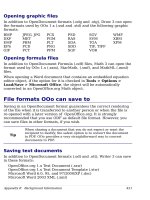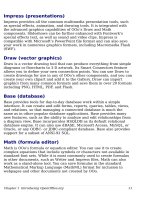Getting Started with Open Office .org 3 part 24 pdf
Bạn đang xem bản rút gọn của tài liệu. Xem và tải ngay bản đầy đủ của tài liệu tại đây (4.77 MB, 10 trang )
This dashed line is the axis of symmetry. The object
will be reflected about this line. Move one or both
ends of the line with your mouse to set the axis.
Then, grab any one of the eight green handles and
move it across to the other side of the dashed line.
The new position of the figure is shown dashed until
the mouse is released.
Note
If you hold down the
Shift
key while moving the line, the line will
rotate in 45-degree increments.
Mirror copies
Officially, this useful command does not (yet) exist in Draw. It can,
however, be easily emulated.
Move the axis of symmetry to the desired location of the mirror axis.
Copy the object to the clipboard. Flip the object, then click on an
empty area of the Draw screen in order to deselect the object. Paste
from the clipboard to put a copy of the object in its original location
and now you have a mirror copy.
Distorting an image
There are three tools on the Effects menu that let you drag the
corners and edges of an object to distort the image.
The Distort tool distorts an object in perspective, the Set to Circle
(slant) and Set in Circle (perspective) tools both create a pseudo
three-dimensional effect. See Chapter 4 of the
Draw Guide
for details.
Dynamic gradients
You can control transparency gradients in the same manner as color
gradients. Both types of gradient can be used together. With a
Chapter 7 Getting Started with Draw 231
transparency gradient, the direction and degree of an object’s fill color
changes from opaque to transparent (in a regular gradient, the fill
changes from one color to another, but the degree of transparency
remains the same). See Chapter 4 of the
Draw Guide
for details.
Duplication
Duplication makes copies of an object while applying a set of changes
(such as color or rotation) to the duplicates. The result of a duplication
is a new group.
To start duplication, click on an object or group and choose Edit >
Duplicate. The dialog shown in Figure 173 appears.
The options chosen in Figure 173 applied to a blue rectangle produce
the following result.
Figure 173: Duplicating an object
232 Getting Started with OpenOffice.org 3
Cross-fading
Cross-fading transforms a shape from one form to another, with
OpenOffice.org handling all of the intermediate transitions. The result
is a new group of objects including the two end points and the
intermediate steps.
To carry out a cross-fade, select both objects (hold the
Shift
key while
selecting each object in turn) and then choose Edit > Cross-fading
The following dialog appears.
On the dialog choose the number of increments (transition steps). You
probably want to have
Cross-fade attributes
and
Same orientation
both
checked. The end result is shown in Figure 174.
Figure 174: Cross-fading example
Combining multiple objects
Using Draw, you can combine drawing objects together in two distinct
ways:
grouping
and
combining
. These two methods allow you to treat
multiple objects as one unit, or to merge objects to form a new shape.
Grouping
is like putting objects in a container. You can move them as a
group and apply global changes to them. A group can always be
undone and the objects that make up the group can always be
manipulated separately.
A
combination
is a permanent fusion of objects leading to a new object.
The original objects are no longer available as individual entities and
the operation is not reversible.
Chapter 7 Getting Started with Draw 233
Grouping by common selection
When several objects are selected, any operations you carry out are
applied to all of the objects. For example, you can rotate a group of
objects in its entirety. Groups obtained through common selection of
several objects are undone as soon as you click outside the group.
However, you can group objects and keep those selected objects
grouped together.
Maintaining groups and undoing groups
To group selected objects, right-click and choose Group from the pop-
up menu. You can also use the keyboard shortcut
Control+Shift+G
or
choose Modify > Group from the menu bar.
When objects are grouped, any editing operations carried out on that
group are applied to all members of the group. If you click on one
member of the group, the whole group is selected.
The objects of a group retain their own individual properties. To undo a
group, right-click and choose Ungroup from the pop-up menu, use the
keyboard shortcut
Control+Alt+Shift+G
or choose Modify >
Ungroup from the menu bar.
You can edit a member of a group individually without breaking the
group. To do this, right-click and choose Enter group or double-click
on the group.
Combining objects
In contrast to grouping functions,
combinations
create a new object;
subsequent “un-combining” in the same manner as ungrouping is not
possible. Select a collection of objects, then right-click and choose
Combine from the pop-up menu.
After you have selected more than one object, the Merge, Subtract,
and Intersect functions can be reached in the Modify > Shapes menu
or though the group’s right-click menu under the heading Shapes.
Aids for positioning objects
Draw has various tools to help you arrange the objects with respect to
each other:
• Moving an object to the front or to the back
• Aligning objects with respect to each other
234 Getting Started with OpenOffice.org 3
• Distributing the distance and space between objects
See Chapter 5 (Combining Multiple Objects) in the
Draw Guide
for
more information.
Editing pictures
Draw contains a number of functions for editing raster graphics
(bitmaps)—for example, photos, scanned pictures, and so on—including
import and and export as well as conversion from one format to
another. Draw can read in all the usual range of graphic file formats.
However, it does not have the same capabilities as the specialized
raster graphics programs like Adobe Photoshop or The Gimp.
See Chapter 6 (Editing Pictures) in the
Draw Guide
for details.
Working with 3D objects
Although Draw does not match the functionality of the leading drawing
or picture editing programs, it does offer a wide array of tools and
methods to produce and edit very good 3D drawings and pictures.
Draw offers two types of 3D objects: the ones carried forward from
OOo version 1,
3D bodies
, and the ones newly introduced in version 2,
3D shapes
. Depending on which type you choose, there are different
possibilities for further editing of the object (rotation, illumination,
perspective). Setting up and editing 3D objects is simpler with 3D
shapes than with 3D bodies, but 3D bodies currently allow for more
customizing than 3D shapes.
See Chapter 7 (Working with 3D Objects) in the
Draw Guide
for details.
Inserting pictures from other sources
You can add pictures from several sources:
• The Gallery—see Chapter 11 (Graphics, the Gallery, and
Fontwork)
• Directly from a scanner (Insert > Picture > Scan)
• Images created by another program, including photographs from
a digitial camera (Insert > Picture > From File)
Draw provides tools for working with bitmap images such as
photographs: the Picture toolbar and the bitmap image management
palette. See the
Draw Guide
for details and examples.
Chapter 7 Getting Started with Draw 235
Exchanging objects with other programs
To save a Draw image in a foreign format, use File > Export. Draw
can save to many graphic file formats, as listed in Chapter 3 (File
Management).
You can also export Draw files to HTML, PDF, or Flash. PDF export is
the same as for any part of OpenOffice.org, as described in Chapter 10
(Printing, E-mailing, and Exporting). Flash export creates a .swf file.
HTML export uses a conversion wizard that creates as many web
pages as there are pages in your Draw document. You can optionally
choose to display the pages in frames with a navigator and can set an
index page. For more information, see Chapter 12 (Creating Web
Pages: Saving Documents as HTML Files).
236 Getting Started with OpenOffice.org 3
Chapter 8
Getting Started with Base
OpenOffice.org’s database component
Introduction
A data source, or database, is a collection of pieces of information that
can be accessed or managed by OpenOffice.org (OOo). For example, a
list of names and addresses is a data source that could be used for
producing a mail merge letter. A shop stock list could be a data source
managed through OOo.
Note
OpenOffice.org uses the terms “Data Source” and “Database” to
refer to the same thing, which could be a database such as
MySQL or dBase or a spreadsheet or text document holding
data.
This chapter covers creating a database, showing what is contained in
a database and how the different parts are used by OOo. It also covers
using the Base component of OOo to register other data sources. A
data source can be a database, spreadsheet, or text document.
Data sources are only introduced in this chapter. For more detailed
information about the use of databases, see the
Database Guide
.
Note
OOo Base uses the HSQL database engine. All of the files
created by this engine are kept in one zipped file. The database
forms are included in this zipped file.
A
database
consists of a number of
fields
that contain the individual
pieces of data. Each
table
of the database is a group of fields. When
creating a table, you also determine the characteristics of each field in
the table.
Forms
are for data entry into the fields of one or more tables
associated with the form. They can also be used for viewing fields from
one or more tables associated with the form. A
query
creates a new
table from the existing tables based upon how you create the query. A
report
organizes the information of the fields of a query in a document
according to your requirements.
Caution
The database in OOo requires Java Runtime Environment (JRE).
If you do not have it on your computer, you can download it
from www.java.com and install it following the instructions on
the site. It should be Java 5.0 or higher. In OOo, use Tools >
Options > OpenOffice.org > Java to register Java.
Windows' version of JRE can not be used, while there are other
versions that can.
238 Getting Started with OpenOffice.org 3
Base creates
relational databases
. This makes it fairly easy to create a
database in which the fields of the database have relationships with
each other.
For example: Consider a database for a library. It will contain a field
for the names of the authors and another field for the names of the
books. There is an obvious relationship between the authors and the
books they have written. The library may contain more than one book
by the same author. This is what is known as a one-to-many
relationship: one author and more than one book. Most if not all the
relationships in such a database are one-to-many relationships.
Consider an employment database for the same library. One of the
fields contains the names of the employees while others contain the
social security numbers, and other personal data. The relationship
between the names and social security numbers is one-to-one: only one
social security number for each name.
If you are acquainted with mathematical sets, a relational database can
easily be explained in terms of sets: elements, subsets, unions, and
intersections. The fields of a database are the elements. The tables are
subsets. Relationships are defined in terms of unions and intersections
of the subsets (tables).
To explain how to use a database, we will create one for automobile
expenses. In the process, we will be explaining how a database work.
Planning a database
The first step in creating a database is to ask yourself many questions.
Write them down, and leave some space between the questions to later
write the answers. At least some of the answers should seem obvious
after you take some time to think.
You may have to go through this process a few times before everything
becomes clear in your mind and on paper. Using a text document for
these questions and answers makes it easier to move the questions
around, add additional questions, or change the answers.
Here are some of the questions and answers I developed before I
created a database for automobile expenses. I had an idea of what I
wanted before I started, but as I began asking questions and listing the
answers, I discovered that I needed additional tables and fields.
What are the fields going to be? My expenses divided into three broad
areas: fuel purchases, maintenance, and vacations. The annual cost for
Chapter 8 Getting Started with Base 239
the car’s license plate and driver’s license every four years did not fit
into any of these. It will be a table of its own: license fees.
What fields fit the fuel purchases area? Date purchased, odometer
reading, fuel cost, fuel quantity, and payment method fit. (Fuel
economy can be calculated with a query.)
What fields fit the maintenance area? Date of service, odometer
reading, type of service, cost of service, and next scheduled service of
this type (for example, for oil changes list when the next oil change
should be). But it would be nice if there was a way to write notes. So, a
field for notes was added to the list.
What fields fit the vacations area? Date, odometer reading, fuel
(including all the fields of the fuel table), food (including meals and
snacks), motel, total tolls, and miscellaneous. Since these purchases
are made by one of two bank cards or with cash, I want a field to state
which payment type was used for each item.
What fields fit into the food category? Breakfast, lunch, supper, and
snacks seem to fit. Do I list all the snacks individually or list the total
cost for snacks for the day? I chose to divide snacks into two fields:
number of snacks and total cost of snacks. I also need a payment type
for each of these: breakfast, lunch, supper, and total cost of snacks.
What are the fields that are common to more than one area? Date
appears in all of the areas as does odometer reading and payment
type.
How will I use this information about these three fields? While on
vacation, I want the expenses for each day to be listed together. The
date fields suggest a relationship between the vacation table and the
dates in each of these tables: fuel and food, This means that the date
fields in these tables will be linked as we create the database.
The type of payment includes two bank cards and cash. So, we will
create a table with a field for the type of payment and use it in list
boxes in the forms.
Tip
While we have listed fields we will create in the tables of the
database, there is one more field that may be needed in a table:
the field for the primary key. In some tables, the field for the
primary key has already been listed. In other tables such as the
payment type, an additional field for the primary key must be
created.
240 Getting Started with OpenOffice.org 3









